AF 447 Search to resume
Join Date: Jun 2009
Location: I am where I am and that's all where I am.
Posts: 660
Likes: 0
Received 0 Likes
on
0 Posts
Machinbird, what would it take to throw something four football fields? Answer that and I'll entertain your notion.
I'd rather expect they were large more or less flat surfaces that could have flown a little as well as fluttered on their way down. That might be pieces of one of the wings. Then, again, it might not. But, THROWN more than four football fields? About the only thing that had a prayer of being thrown that far would be the VS. And we know where it was found.
I'd rather expect they were large more or less flat surfaces that could have flown a little as well as fluttered on their way down. That might be pieces of one of the wings. Then, again, it might not. But, THROWN more than four football fields? About the only thing that had a prayer of being thrown that far would be the VS. And we know where it was found.
Join Date: Jun 2009
Location: I am where I am and that's all where I am.
Posts: 660
Likes: 0
Received 0 Likes
on
0 Posts
HarryMann, auv-ee is exactly what his moniker implies. He is involved in the AUV industry as an EE. We've conversed a bit. He's anything but dumb or ignorant of the underseas environment.
Something of note on my personal experience is that I've watched activities at levels a little below the surface and thanks to BP's many streaming videos under very deep water. I could see no salient differences in the way materials moved or the vehicles moved. Water does not get thicker or denser as you go down except by very small amounts. It's viscosity/pressure profile shows very little change until you hit the phase change that turns it into some form of ice. Water is NOT thick air. So you cannot infer much of anything from your experience with air.
Something of note on my personal experience is that I've watched activities at levels a little below the surface and thanks to BP's many streaming videos under very deep water. I could see no salient differences in the way materials moved or the vehicles moved. Water does not get thicker or denser as you go down except by very small amounts. It's viscosity/pressure profile shows very little change until you hit the phase change that turns it into some form of ice. Water is NOT thick air. So you cannot infer much of anything from your experience with air.
Join Date: Jun 2009
Location: Canada
Posts: 464
Likes: 0
Received 0 Likes
on
0 Posts
From what I remember the belief as of a few years ago was that the Titanic's bow broke off at the surface, and the stern then turned around before sinking. New evidence might have changed that since.
Join Date: May 2010
Location: MA, USA
Posts: 126
Likes: 0
Received 0 Likes
on
0 Posts
HarryMann:
I am generally aware of the effect of Reynold's Number on drag regimes, but as this is not my area (I am an EE, as JD says), I can only say that it is my understanding, from having "watched hydrodynamics done" , that form drag dominates for the conditions of interest here. If anyone still cares at the end of the week, when I return from travel, I will ask an ME who does this sort of work for a more definitive answer.
, that form drag dominates for the conditions of interest here. If anyone still cares at the end of the week, when I return from travel, I will ask an ME who does this sort of work for a more definitive answer.
Outliers:
The target to the north might, as others have suggested, be a piece that drifted on the surface before filling with water and sinking, or it might be something that is not related to AF447.
I am generally aware of the effect of Reynold's Number on drag regimes, but as this is not my area (I am an EE, as JD says), I can only say that it is my understanding, from having "watched hydrodynamics done"
 , that form drag dominates for the conditions of interest here. If anyone still cares at the end of the week, when I return from travel, I will ask an ME who does this sort of work for a more definitive answer.
, that form drag dominates for the conditions of interest here. If anyone still cares at the end of the week, when I return from travel, I will ask an ME who does this sort of work for a more definitive answer.Outliers:
The target to the north might, as others have suggested, be a piece that drifted on the surface before filling with water and sinking, or it might be something that is not related to AF447.
Join Date: Jul 2009
Location: Not far from a big Lake
Age: 81
Posts: 1,454
Likes: 0
Received 0 Likes
on
0 Posts
Machinbird, what would it take to throw something four football fields? Answer that and I'll entertain your notion.
I'd rather expect they were large more or less flat surfaces that could have flown a little as well as fluttered on their way down. That might be pieces of one of the wings. Then, again, it might not. But, THROWN more than four football fields? About the only thing that had a prayer of being thrown that far would be the VS. And we know where it was found.
I'd rather expect they were large more or less flat surfaces that could have flown a little as well as fluttered on their way down. That might be pieces of one of the wings. Then, again, it might not. But, THROWN more than four football fields? About the only thing that had a prayer of being thrown that far would be the VS. And we know where it was found.
The large parts significantly away from the centerline are more what I'm interested in. They are located roughly in the center of the field E-W and are in a rough N-S alignment and located over a greater distance than their original location on the aircraft would account for.
AUV-EE's comment about items circling or spiraling in their descent applies. There is nothing to stabilize them except their own rotational inertia. Only when you begin to consider ship size objects do these inertial stabilization effects become really significant (really big circles).
Join Date: Oct 2009
Location: berlin
Posts: 152
Likes: 0
Received 0 Likes
on
0 Posts
@JD-EE the viscosity of water changes a little bit with the amaunt of salt in it.....
but if air is part of the bouyancy, this air will be compressed under the waterpressure, so in that case the bouyancy decrease with deph, and this objekt then sinks faster
To the wing: now I think it is the right wing, (not the left) seen from the front
the text "do not walke outside this area" is written two times on each wing
but if air is part of the bouyancy, this air will be compressed under the waterpressure, so in that case the bouyancy decrease with deph, and this objekt then sinks faster
To the wing: now I think it is the right wing, (not the left) seen from the front
the text "do not walke outside this area" is written two times on each wing
grity wrote:
This sort of shows it:
Photos: Airbus A330-203 Aircraft Pictures | Airliners.net
edit:
see also
Photos: Airbus A330-203 Aircraft Pictures | Airliners.net
and
Photos: Airbus A330-203 Aircraft Pictures | Airliners.net
2nd edit:
Really going out on a limb here ... the block of French text is longer than the block of English text.
It looks like the French text block appears inboard on the trailing edge labelling of each wing, and outboard on the leading edge labelling.
On the left wing, it therefore looks like the block of English text is on the left, with the block of French on the right, in both places.
But on the right wing, it looks like the English text is on the right for each.
If that's correct, since the image you posted has the English block on the left, this suggests it is the left wing.
Anyone have better eyes or access to the full size picture, which would assist?
the text "do not walke outside this area" is written two times on each wing
Photos: Airbus A330-203 Aircraft Pictures | Airliners.net
edit:
see also
Photos: Airbus A330-203 Aircraft Pictures | Airliners.net
and
Photos: Airbus A330-203 Aircraft Pictures | Airliners.net
2nd edit:
Really going out on a limb here ... the block of French text is longer than the block of English text.
It looks like the French text block appears inboard on the trailing edge labelling of each wing, and outboard on the leading edge labelling.
On the left wing, it therefore looks like the block of English text is on the left, with the block of French on the right, in both places.
But on the right wing, it looks like the English text is on the right for each.
If that's correct, since the image you posted has the English block on the left, this suggests it is the left wing.
Anyone have better eyes or access to the full size picture, which would assist?
Last edited by auraflyer; 17th Apr 2011 at 07:07.
auraflyer;
I've worked with the images a bit to bring out greater detail. Unfortunately the highlights have no detail at all and just "gray down" so I've left them as is.
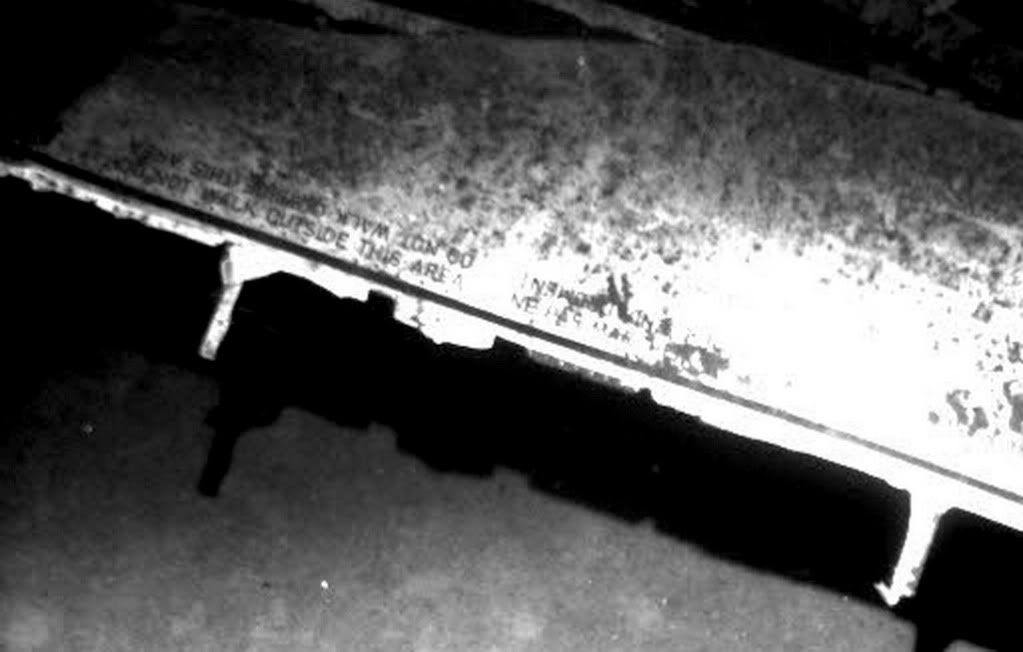
As suggested I think we're looking at the left wing aileron mounts in the above photo.
In the same image, but on the right in the dark background may be the slat tracks and perhaps some of the anti-ice plumbing:
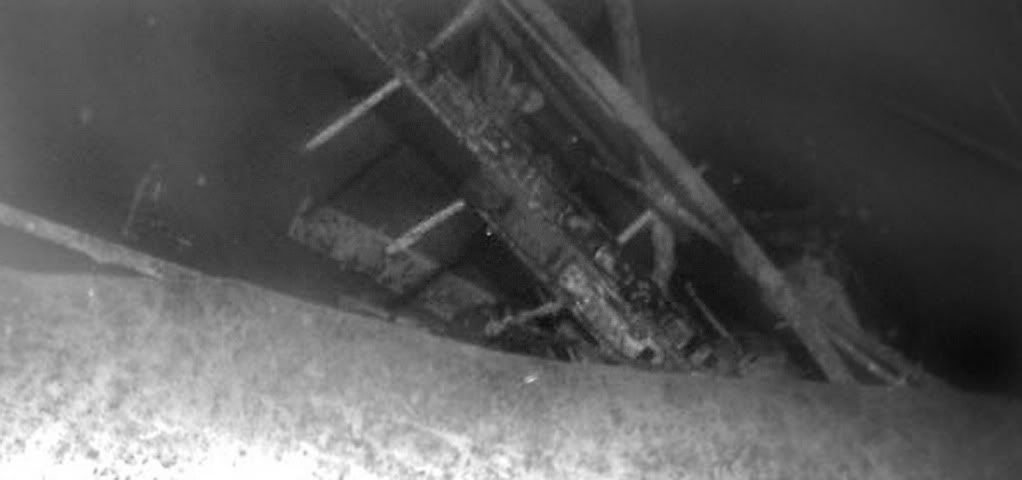
In the following image of the right wing, looking forward, I now wonder if the flap track to the right of the photograph is the #2 track on the right wing, and where the engine pylon was is just to the left where the horizontal "V" is in the skin-join, and the where the #1 flap track was is just to the right of the gear.
I believe this after examining a number of drawings and suitable photographs; - the distance from the MLG to the still-visible flap track is too long for that track to be the #1. If true, it means the pylon is completely missing along with the main wing box forward of the rear spar to which the rear trunnion of the gear is fastened. The rivet and fastener detail is over-exposed in this area and the detail is difficult to bring out.
In fact it is apparent that all the lighter structure forward and aft of the wing box is separated...all flight controls etc and their support structures are all that remain.
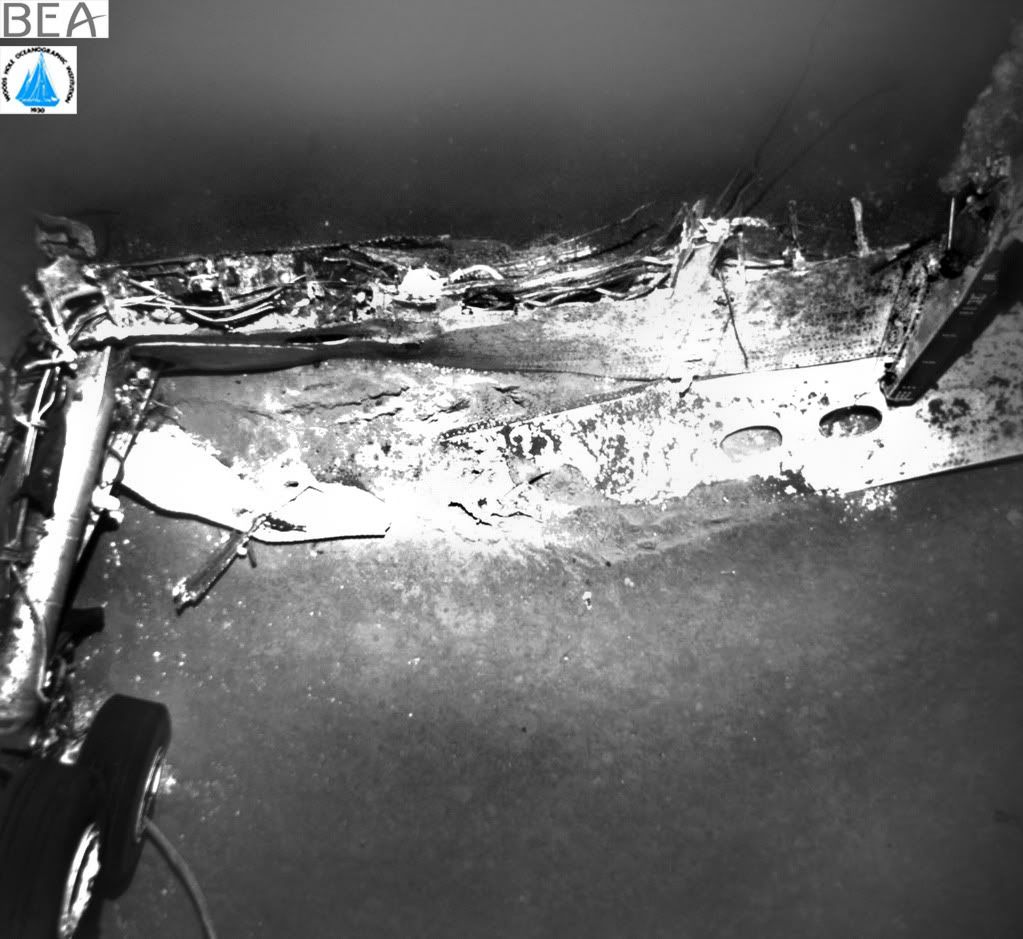
In the following image, (which I have rotated 90deg CCW), of the left MLG, if we look at the retract cylinder, it can be seen that it, and the side brace have sheared from their fittings on the MLG strut. Also, the small uplock pin near the bottom of the strut (two small 'ears') is missing, lending some support to the notion that the gear broke away and began its extension at impact, as discussed.

Two re-worked images of the engine to bring out greater detail:
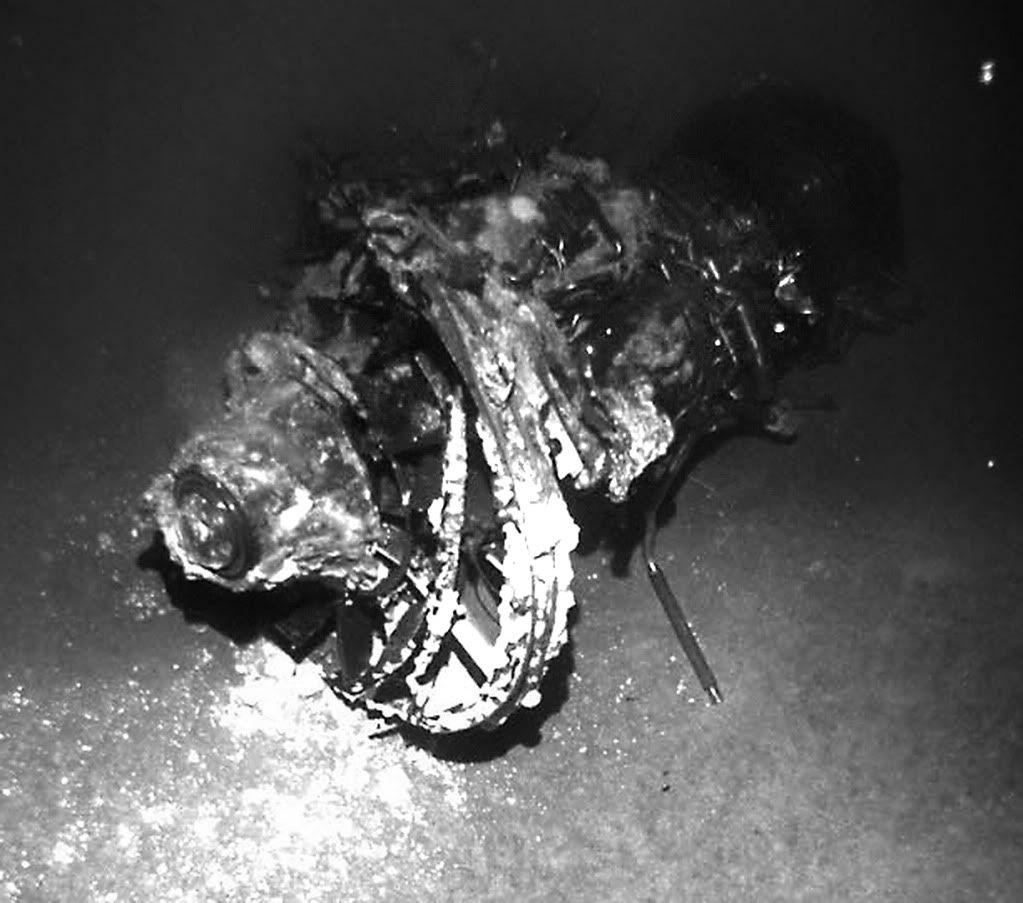
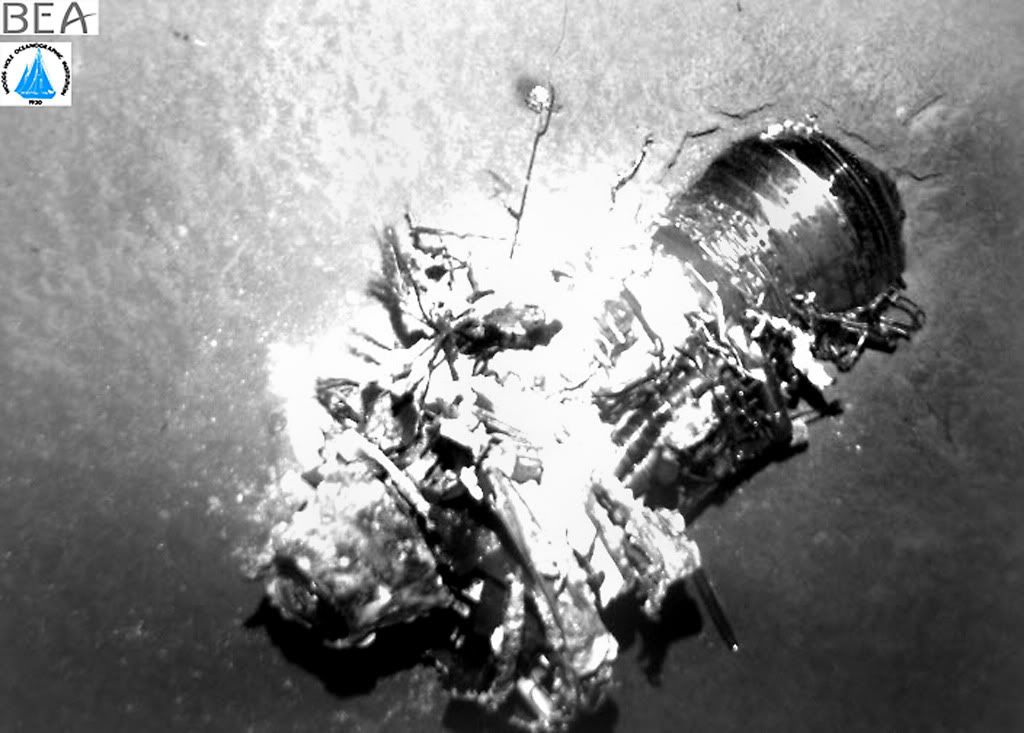
I've worked with the images a bit to bring out greater detail. Unfortunately the highlights have no detail at all and just "gray down" so I've left them as is.

As suggested I think we're looking at the left wing aileron mounts in the above photo.
In the same image, but on the right in the dark background may be the slat tracks and perhaps some of the anti-ice plumbing:

In the following image of the right wing, looking forward, I now wonder if the flap track to the right of the photograph is the #2 track on the right wing, and where the engine pylon was is just to the left where the horizontal "V" is in the skin-join, and the where the #1 flap track was is just to the right of the gear.
I believe this after examining a number of drawings and suitable photographs; - the distance from the MLG to the still-visible flap track is too long for that track to be the #1. If true, it means the pylon is completely missing along with the main wing box forward of the rear spar to which the rear trunnion of the gear is fastened. The rivet and fastener detail is over-exposed in this area and the detail is difficult to bring out.
In fact it is apparent that all the lighter structure forward and aft of the wing box is separated...all flight controls etc and their support structures are all that remain.

In the following image, (which I have rotated 90deg CCW), of the left MLG, if we look at the retract cylinder, it can be seen that it, and the side brace have sheared from their fittings on the MLG strut. Also, the small uplock pin near the bottom of the strut (two small 'ears') is missing, lending some support to the notion that the gear broke away and began its extension at impact, as discussed.

Two re-worked images of the engine to bring out greater detail:


Join Date: Jun 2009
Location: NNW of Antipodes
Age: 81
Posts: 1,330
Received 0 Likes
on
0 Posts
PJ2;
I was looking at the last photograph of the engine and realized that it had probably arrived at the bottom rear end first. The reason for saying that is the small crater visible there, but no signs of a heavy landing on the forward end.
Likewise, the MLG has a a pair of wheels that have dug in, but everything else is pristine, with no signs of current scour round any of the photographed items.
Its very obvious that the impact trauma was extreme.
I was looking at the last photograph of the engine and realized that it had probably arrived at the bottom rear end first. The reason for saying that is the small crater visible there, but no signs of a heavy landing on the forward end.
Likewise, the MLG has a a pair of wheels that have dug in, but everything else is pristine, with no signs of current scour round any of the photographed items.
Its very obvious that the impact trauma was extreme.
Join Date: Feb 2001
Location: UK
Posts: 647
Likes: 0
Received 0 Likes
on
0 Posts
MM3 - just clariifying - you mean the impact trauma at the sea surface/ditching, not at the sea bed when these things hit bottom?
(By the way, many thanks to you and the other well-informed people on here who contribute so much really helpful technical data and research, and have put up, with far more patience than I would have, the ill-informed queries and theories of people who know notthing and think they know a lot!)
(By the way, many thanks to you and the other well-informed people on here who contribute so much really helpful technical data and research, and have put up, with far more patience than I would have, the ill-informed queries and theories of people who know notthing and think they know a lot!)
Join Date: Oct 2009
Location: berlin
Posts: 152
Likes: 0
Received 0 Likes
on
0 Posts
On the left wing, it therefore looks like the block of English text is on the left, with the block of French on the right, in both places.
if airfrance never changed the side of the text, it must be the LEFTwing!, but possible the break line along the middle of the wing deludes us, and we even look from the front to the wing..... the fuselage then was to the left side of the picture and not to the right??? grity
Per Ardua ad Astraeus
Join Date: Mar 2000
Location: UK
Posts: 18,579
Likes: 0
Received 0 Likes
on
0 Posts
chrisN -"you mean the impact trauma at the sea surface/ditching" - absolutely, in my book. I cannot see any way that a wing section could hit the seabed hard enough to cause that damage. I might surmise that a wing section, if tumbled along the sea bed by strong currents, could be extensivley damaged, but since it appears to lie near the other debris I think that scenario is unlikley.
As BEA proposed, some impact.
As BEA proposed, some impact.
Well, no expert but...
If the separation into parts occured at impact with the sea the dispersion during the fall to the sea bed was relatively limited (what is the main debris field 400m by 50m ?) and unchaotic (linear). The l:d ratio of the debris is about 8:1 excluding outliers, that of the pristine fuselage about 12:1 as I understand ( 60m x 5m).
Is it a coincidence that in its basic form it reflects the geometry of the original structure ?
There is no 'fanning' at either end visible as you might expect if parts were being sorted by density and slowly separated.
Presumably at least some of the linear stretch would be due to the motion as the aircraft slewed across the surface after impact and isn't it at that phase, were there is reasonable speed compared to any subsequent current, that any sorting by form factor/density etc would have occured.
Is everyone so sure that the orientation of the debris doesn't give more information ? If the fwd and aft ends of the a/c are subsequently found at either end of the debris trail, it would be a clincher wouldn't it ie (ie that the debris reflects heading at impact)?
If the main structure stayed together, then perhaps not, but then would you expect the separated parts to so neatly fall in line ?
As the ratio of structure dimension to debris trail doesn't depart much from the original, about 10:1 each way (and there is plenty of rough calc here), perhaps consistent with a limited fwd speed relative to vertical at impact.
If the separation into parts occured at impact with the sea the dispersion during the fall to the sea bed was relatively limited (what is the main debris field 400m by 50m ?) and unchaotic (linear). The l:d ratio of the debris is about 8:1 excluding outliers, that of the pristine fuselage about 12:1 as I understand ( 60m x 5m).
Is it a coincidence that in its basic form it reflects the geometry of the original structure ?
There is no 'fanning' at either end visible as you might expect if parts were being sorted by density and slowly separated.
Presumably at least some of the linear stretch would be due to the motion as the aircraft slewed across the surface after impact and isn't it at that phase, were there is reasonable speed compared to any subsequent current, that any sorting by form factor/density etc would have occured.
Is everyone so sure that the orientation of the debris doesn't give more information ? If the fwd and aft ends of the a/c are subsequently found at either end of the debris trail, it would be a clincher wouldn't it ie (ie that the debris reflects heading at impact)?
If the main structure stayed together, then perhaps not, but then would you expect the separated parts to so neatly fall in line ?
As the ratio of structure dimension to debris trail doesn't depart much from the original, about 10:1 each way (and there is plenty of rough calc here), perhaps consistent with a limited fwd speed relative to vertical at impact.
Last edited by Mr Optimistic; 17th Apr 2011 at 12:55. Reason: throw in some numbers
Thanks Grity. I think the French might read "Ne pas marcher a l'exterieur de l'encadrement", which would make sense, but I'm not certain.
Best image I can find is Photos: Airbus A330-203 Aircraft Pictures | Airliners.net
PJ2, great work on the pics. I don't know enough to comment on your identification re the flap track, but looking at p13 of the BEA 2nd report, I think none of the lighter structures forward were recovered (in fact from either wing).
Best image I can find is Photos: Airbus A330-203 Aircraft Pictures | Airliners.net
PJ2, great work on the pics. I don't know enough to comment on your identification re the flap track, but looking at p13 of the BEA 2nd report, I think none of the lighter structures forward were recovered (in fact from either wing).
Last edited by auraflyer; 17th Apr 2011 at 12:56.
Condition of MLGs
Quote from mm43:
the MLG has a a pair of wheels that have dug in, but everything else is pristine,
Quote from PJ2, re Left MLG assembly:
Also, the small uplock pin near the bottom of the strut (two small 'ears') is missing, lending some support to the notion that the gear broke away and began its extension at impact, as discussed.
(Thanks for the enhanced images!) Yes, what a noteworthy difference between both MLGs and the rest of the debris...
the MLG has a a pair of wheels that have dug in, but everything else is pristine,
Quote from PJ2, re Left MLG assembly:
Also, the small uplock pin near the bottom of the strut (two small 'ears') is missing, lending some support to the notion that the gear broke away and began its extension at impact, as discussed.
(Thanks for the enhanced images!) Yes, what a noteworthy difference between both MLGs and the rest of the debris...
Alignment of Sea-bed Debris Field versus Heading at Sea-level Impact
Quotes from Mr Optimistic:
Is it a coincidence that in its basic form it reflects the geometry of the original structure ?
...Is everyone so sure that the orientation of the debris doesn't give more information ? If the fwd and aft ends of the a/c are subsequently found at either end of the debris trail, it would be a clincher wouldn't it... ...?
At risk of looking foolish all over again (my back is broad), I shall merely say that I notice a degree of hesitance (wouldn't go quite as far as to say inconsistency) in some of the analyses on this subject.
Sometimes, what is staring you in the face can be dismissed as just too simple to be true. I still wonder.
Is it a coincidence that in its basic form it reflects the geometry of the original structure ?
...Is everyone so sure that the orientation of the debris doesn't give more information ? If the fwd and aft ends of the a/c are subsequently found at either end of the debris trail, it would be a clincher wouldn't it... ...?
At risk of looking foolish all over again (my back is broad), I shall merely say that I notice a degree of hesitance (wouldn't go quite as far as to say inconsistency) in some of the analyses on this subject.
Sometimes, what is staring you in the face can be dismissed as just too simple to be true. I still wonder.
Last edited by Chris Scott; 17th Apr 2011 at 14:31. Reason: Title improved.
Join Date: Oct 2007
Location: France
Posts: 136
Likes: 0
Received 0 Likes
on
0 Posts
Hi,
By looking at auraflyer wing picture link and the BEA picture, it seems that many "details" are suggesting a rear view of the left wing:

(The images were distorted to compensate for different viewing angles. Without clear picture of the A330 wing leading edge structure, a small doubt subsists).
By looking at auraflyer wing picture link and the BEA picture, it seems that many "details" are suggesting a rear view of the left wing:

(The images were distorted to compensate for different viewing angles. Without clear picture of the A330 wing leading edge structure, a small doubt subsists).
Join Date: Oct 2007
Location: France
Posts: 136
Likes: 0
Received 0 Likes
on
0 Posts
Hi,
IF the BEA picture shows the left wing, and IF the writings are in the same place as on the picture http://cdn-www.airliners.net/aviatio.../9/1365991.jpg of the auraflyer post, they are n°2 and 3 according to this post : http://www.pprune.org/tech-log/39510...ml#post5722863
So, the wreckage in the upper right corner of the BEA picture could be part of the leading edge structure? With the 3 parallel "ribs" (?) from the wing intrados?
But ... make no mistake:I am just a curious with no knowledge in aeronautics nor a/c!
Originally Posted by Chris Scott
Can you say which spoilers they are? 2 & 3?
So, the wreckage in the upper right corner of the BEA picture could be part of the leading edge structure? With the 3 parallel "ribs" (?) from the wing intrados?
But ... make no mistake:I am just a curious with no knowledge in aeronautics nor a/c!
Join Date: Jun 2009
Location: I am where I am and that's all where I am.
Posts: 660
Likes: 0
Received 0 Likes
on
0 Posts
Alignment of Sea-bed Debris Field versus Heading at Sea-level Impact
Chris and others....
Here is a fairly simple experiment to carry out. Get a tall pail or bucket. Fill it with water. Let it sit awhile so that it's stopped all motion.
While it is stopping raid, a sewing kit for some needles, buttons of various sizes, thimbles, and so forth. (Don't mess up any of the bobbins or things like that. Be kind to the owner of the sewing kit.) Create an arrangement to have them fall straight into the water. See if you notice any patterns that appear when the debris hits the bottom and settles.
A taller the bucket and the wider the array of objects will probably give clearer results.
The results I am looking for are similar to the arcade type gadgets which have you drop a coin through water to get it into a specific slot. These gadgets make a lot of money. The coins all flutter and slip aside.
Draw conclusions as you will. I contend that the array on the bottom is fairly surprisingly compact. Currents must have been really slow compared to the rate of fall through them.
Here is a fairly simple experiment to carry out. Get a tall pail or bucket. Fill it with water. Let it sit awhile so that it's stopped all motion.
While it is stopping raid, a sewing kit for some needles, buttons of various sizes, thimbles, and so forth. (Don't mess up any of the bobbins or things like that. Be kind to the owner of the sewing kit.) Create an arrangement to have them fall straight into the water. See if you notice any patterns that appear when the debris hits the bottom and settles.
A taller the bucket and the wider the array of objects will probably give clearer results.
The results I am looking for are similar to the arcade type gadgets which have you drop a coin through water to get it into a specific slot. These gadgets make a lot of money. The coins all flutter and slip aside.
Draw conclusions as you will. I contend that the array on the bottom is fairly surprisingly compact. Currents must have been really slow compared to the rate of fall through them.
Last edited by Jetdriver; 17th Apr 2011 at 16:20.



